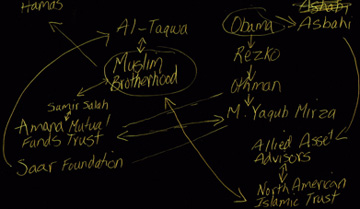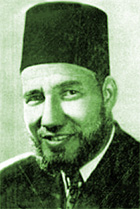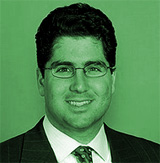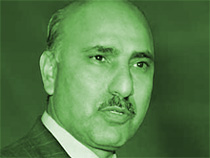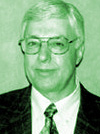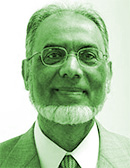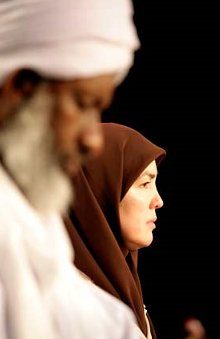|
January 2009
Barack Obama and The Muslim Brotherhood January 11, 2008
As these authors write these words, Israel is conducting a major ground assault in the Gaza Strip. Israeli ground troops and heavy armor have moved deep into the Gaza Strip ("Israeli forces split Gaza in two" - see below 'Sources Cited' ).
According to the BBC, the move has, in effect, cut the territory in two (ibid).
Muslim Brotherhood Diagram
This ground assault followed hot on the heels of Operation Cast Lead, a December 27-28 series of Israeli airstrikes conducted in Gaza in response to Hamas' refusal to renew the truce brokered by Egypt in the summer of 2008 (Khalil, "The already-strained Hamas-Egypt relationship sours").
Hamas had been launching rocket attacks into Israel
since December 24, when no less than 70 rockets hit the small Jewish state,
and Israel decided to strike back ("Israeli jets hit Hamas target, killing
1").
The President-elect even went as far as to condemn former President Jimmy Carter for meeting with Hamas (ibid). But the words of Ahmed Yousef, a top Hamas political advisor, during a WABC interview, seem to suggest that Obama's opposition to Hamas may be a mere public relations ploy.
During the interview, Yousef stated:
Why would Hamas support an Obama presidency? The
answer may lie in a group known as the Muslim Brotherhood.
The Muslim Brotherhood
Hassan al-Banna
According to former CIA operative Robert Baer, Hamas was an offshoot of the Egyptian branch of the Muslim Brotherhood (172).
Founded in 1928 by an Egyptian schoolteacher named Hassan al-Banna with the expressed purpose of purifying Islam, the Muslim Brotherhood is anything but a benign Muslim organization (172).
According to Baer, the Brotherhood "is another of the cauldrons from which al Qaeda emerged" (172).
Khalid Sheik Mohammed, the architect of the September 11 attacks, joined the Muslim Brotherhood at the age of sixteen and attended the Brotherhood's desert youth camps (Mintz and Farah, "In Search of Friends Among Foes").
Ayman Zawahiri, Osama bin Laden's deputy, was a member of the Muslim Brotherhood's Egyptian branch (ibid). According to Seymour Hersh, the Brotherhood may have even been involved in the September 11 attacks. Hersh states:
The Brotherhood's hatred of the United States was clearly expressed in a 1991 internal memorandum written by Mohamed Akram for the
Entitled "An Explanatory Memorandum on the General Strategic Goal for the Brotherhood in North America," the document states that the Brotherhood's activities in the United States represent:
Akram's memorandum failed to mention the powerful, white, English-speaking individuals that have given assistance to the Brotherhood's "grand Jihad."
The Muslim Brotherhood is not only a radical and dangerous party; it is intimately tied to the power elite.
This connection probably had its start prior to World War Two when British travel writer and intelligence agent Freya Stark forged an alliance between the Brotherhood and British intelligence (Dorril 622). Brotherhood collaboration with Western intelligence continued with an alliance between the Brotherhood and the CIA that began around 1955.
According to former CIA agent Miles Copeland, it
was around this time that America began looking for the Muslim equivalent of
Billy Graham, hoping to use such a charismatic individual to influence the
Arab world. When this failed, the Agency began forging ties with the Muslim
Brotherhood (Aburish 60-61).
On June 20, 2007, the Bureau of Intelligence and Research at the State Department hosted a meeting with other intelligence community representatives to discuss the opening of "more formal channels" to the Muslim Brotherhood (Lake, "Bush Weighs Reaching Out to 'Brothers'").
One of the Brotherhood supporters at the June 20 meeting was Robert Leiken (ibid).
Robert Leiken, a scholar at the Nixon Center, was commissioned by the National Intelligence Council to put together a paper on the history of the Muslim Brotherhood earlier in 2007 (ibid).
According to administration officials, Leiken's paper to the National Intelligence Council drew the attention of Secretary of State Condoleezza Rice and senior members of the National Security Council (ibid).
George W. Bush even encouraged
Tariq al-Hashemi,
the leader of the Iraq branch of the Muslim Brotherhood, to form an alliance
to oppose Prime Minister Nouri al-Maliki (Slavin, "Iraqi VP says Bush wants
coalition to counter al-Sadr").
Unfortunately, there is evidence that the
Brotherhood will maintain its audience with Washington circles during the Obama reign.
The Democrats' Answer to Grover Norquist
Mazen Asbahi
When the Obama campaign needed an individual to reach out to the Muslim community, it turned to Chicago lawyer Mazen Asbahi for help (Simpson and Chozick, "Obama's Muslim-Outreach Adviser Resigns").
But Asbahi's connections to the Muslim
Brotherhood did more to raise questions than it did to bridge gaps. By
August of 2008, Asbahi had resigned from his position as volunteer
coordinator for Muslim American affairs for the Obama campaign (ibid).
Eight years before taking up the Obama cause, Asbahi served on the Board of the Allied Asset Advisors (Spencer, "Obama's Muslim Outreach Problem").
Allied Asset Advisors is a subsidiary of the North American Islamic Trust (NAIT) (ibid).
According to the 1991 internal memorandum authored by Akram for the Muslim Brotherhood, NAIT is part of the network conducting the Brotherhood's "grand jihad" ("An Explanatory Memorandum on the General Strategic Goal for the Brotherhood in North America").
NAIT is also connected to the Holy Land Foundation (HLF), an organization believed to be involved in the financing of Muslim Brotherhood offshoot Hamas (Josh Gerstein, "US: Facts Tie Muslim Groups To Hamas Front Case").
According to the prosecutors in the HLF case, NAIT has an,
When the Wall Street Journal and other media organs began raising questions, Asbahi quickly went to work on damage control.
The Chicago lawyer claimed he resigned from Allied Asset Advisors' board immediately after learning about fellow board member Jamal Said's connection to Hamas (Simpson and Chozick, "Obama's Muslim-Outreach Adviser Resigns").
However, Asbahi later admitted that his resignation from the Obama campaign was purely a "strategic decision," suggesting that the explanation for his involvement in the Allied Asset Advisors was contrived (Spencer, "Obama's Muslim Outreach Problem").
Asbahi's alibi further disintegrated on September 15, 2008 when the former Muslim liaison met with members of the Council on American-Islamic Relations (CAIR) (ibid).
CAIR's parent organization, the Islamic Association for Palestine, is named in Akram's Muslim Brotherhood memorandum as part of the Brotherhood's "grand jihad" network (ibid). Asbahi's resignation did not end the Obama campaign's love affair with the Muslim Brotherhood.
Also present at the September 15, 2008 meeting
was Asbahi's replacement as the Obama campaign's Muslim liaison, Minha
Husaini (ibid).
Rezko, Othman, and Al Taqwa
Antoin "Tony" Rezko
Obama may also connect to the Muslim Brotherhood through his old Chicago mob friends.
Antoin "Tony" Rezko, a Syrian-American political fundraiser and Chicago real estate developer provides the bridge. On June 4, 2008, Rezko was found guilty in federal court on 16 corruption charges ("Rezko begins serving time immediately").
It seems that when Rezko wasn't busy
helping his friends in the Illinois political scene, such as
scandal-embroiled Governor Rod Blagojevich and Obama, he was knee-deep in a
kickback scheme that involved taking bribes from companies that desired
state contracts (ibid).
It was the beginning of a beautiful political friendship. Rezko helped bankroll Obama in five election runs (Fusco, et al., "Obama explains Rezko relationship to Sun-Times").
After some ducking and weaving, Obama admitted to receiving $250,000 from Rezko's fundraising efforts (ibid).
According to the Chicago Sun-Times, this amount was,
Talat Othman
Standing behind Rezko is Talat Othman, a leader in the American Muslim community in Illinois and an extremely successful Arab American businessman.
It was Othman who introduced Rezko to former Illinois governor Jim Edgar and it was Othman who aided Rezko in gaining access to Illinois political circles (Hanania, "Arabs in Chicago discover political clout and controversy").
Rezko was also recognized as "Entrepreneur of the Decade" by Othman's Arab-American Business and Professional Association (ibid).
Othman has a close relationship with M. Yaqub Mirza, a naturalized Pakistani businessman and physicist (Trento 336). Othman and Mirza were co-chairmen of the Islamic Society of North America 2001 Convention (336).
M. Yaqub Mirza
The two were also involved in Amana Mutual Funds Trust, an Islamic mutual fund which, according to investigative journalist Joseph Trento,
Othman sits on Amana's board and Mirza served as the mutual fund's chairman (336).
According to Guidera and Simpson, the Green Quest investigators were "most interested in Mr. Mirza's role as an officer in the Saar Foundation, a nonprofit started in the 1970s by members of the Saudi Arabia's al-Rajihi family, which has interest in banking, construction, and real estate" (ibid).
Stephen Schwartz identifies the Saar
Foundation as the "keystone" to the Mirza-related network ("Wahhabis in the
Old Dominion").
The Al-Taqwa shell game was originally based in Switzerland and had as one of its leading figures a notorious Nazi disciple named Ahmed Huber (ibid).
It was an extensive network that included companies based in the Bahamas, Switzerland, and Liechtenstein (Hosenball, "Attacking the Money Machine").
Al Taqwa even had a foothold in the United States until after September 11 when its assets were frozen and its operations were shut down by a U.S. presidential order ("Wahhabis in the Old Dominion"). According to a Newsweek investigation, the Al Taqwa network "was set up in the 1980s by prominent members of the Muslim Brotherhood" ("Attacking the Money Machine").
Al-Taqwa' chairman, Youssef Nada, even admitted
to being a member of the Brotherhood for 50 years (ibid). Apparently, the Green Quest raids made Othman extremely nervous.
Two weeks after the raids, Othman and several other Muslim activists met with Secretary of the Treasury Paul O'Neill to protest the raids (Trento 337).
Was Othman afraid that the investigation would connect him to the Muslim Brotherhood's plan for a "grand jihad"? Four individuals who were targets of the investigation were affiliated with Amana, the mutual fund where Othman serves as a trustee (337).
It is also interesting to note that another
Amana board member, Samir Salah, is known to have ran a Caribbean branch of
the Muslim Brotherhood's Al-Taqwa network ("Wahhabis in the Old Dominion").
The 44th President may be trying to hide a much more disturbing reality from the eyes of the public. That reality is the fact that our own government, in league with the power elite, will continue collaborating with America's enemies.
The "grand Jihad" proclaimed by Akram in his 1991 memorandum does not only constitute the Muslim Brotherhood's crusade to destroy Western civilization. It also constitutes the power elites's war on the plebeians.
The Muslim Brotherhood is still very close to its Hamas offshoot. If the new administration was too supportive of Israel in its efforts to end the terrorist attacks, it could potentially alienate its Muslim Brotherhood connections.
Those connections may prove useful when the new
administration unveils its
plans for Iran.
This faction seeks to redirect the American Empire's hostilities away from Iran and focus them on Russia and China (ibid).
Such a plan requires that Iran be transformed into an asset, which means that Tehran's efforts to procure nuclear weapons may even be tolerated, so long as Iran is willing to act as a nuclear proxy of the American Empire (ibid).
Iran has long desired to revive the Persian Empire, and Trilateralists such as Carter's former National Security Advisor Zbigniew Brzezinski believe that they can insure that a revived Persian Empire is merely an extension of the American Empire.
For Obama, diplomacy really means imperial recruitment.
The Muslim Brotherhood could provide the bridge in the recruitment process. According to Robert Baer, Iran has substantial ties with Jordan's branch of the Muslim Brotherhood, known as the Islamic Action Front (178).
Hamas, the Muslim Brotherhood offshoot currently fighting with Israel, is also extremely close to Iran.
Iran first began establishing contact with Hamas in 1992, when Israel expelled 415 members of Hamas's leadership as punishment for their involvement in the first intifada, which was a Palestinian uprising against Israeli rule (172).
When the exiled leaders crossed the border into Jordan, they found Hezbollah, a Shi'a paramilitary organization that acts as Iran's Lebanese proxy, waiting for them with open arms (172).
Hezbollah provided the Hamas leaders with tents, clothes, and food (172-173). A few days later, an Iranian Revolutionary Guard officer also arrived on the scene to provide assistance to the Hamas leaders (173).
Without a doubt, the Muslim Brotherhood and Iran
are becoming extremely close as Iran attempts to co-opt every major movement
and political party in the region as part of its bid for empire.
But that means the new President may not be as supportive of Israel in its struggle with Hamas. Obama may even pressure Israel to come to the table of diplomacy and establish yet another truce with Hamas.
The 1988 Hamas Covenant, however, painfully illustrates why peace overtures on Israel's part would be an act of folly.
Article seven of the covenant states:
Article 28 reiterates the document's anti-Jewish theme when it states:
Obviously, the idea of Israel establishing a truce with a group that adheres to such ideas is unthinkable.
It would merely give Hamas an opportunity to lick its
wounds and continue to prepare for the day when it hopes to finally wipe
Israel from the face of the earth.
Instead of facilitating Iran's departure from radicalism, Obama and his puppeteers will work to turn the radicals against the American Empire's competitors, such as Russia and China.
A chance to move Iran in a moderate direction will slip away as Obama and his Establishment handlers try to employ the country as an asset in their fight for dominance in the New World Order.
In the process, Obama will help expedite the Brotherhood's "grand Jihad."
Obama supporters everywhere believe that the event represents the introduction of the solution to America's deepening crisis. It would break not a few hearts, however, if it was revealed that the enemies of America are going to be in attendance.
According to a January 14 Associated Press article, a prayer will be offered at the inauguration by Ingrid Mattson, the first woman president of America's largest Muslim group, the Islamic Society of North America (ISNA) (Zoll, "Muslim woman, rabbis to pray at inaugural service").
While many Americans may believe that this prayer offering represents a celebration of religious pluralism, the hidden message behind this display, which is only discernible to the power elite and the most astute observer, is that members of the Establishment will continue their torrent love affair with the Muslim Brotherhood.
The first installment of this series established the Muslim Brotherhood as a dangerous organization that is partially responsible for spawning al Qaeda.
Furthermore, the Brotherhood has a long running,
symbiotic relationship with the power elite and the darker factions of the
United States government and the intelligence community.
In 2001, evidence began to surface that HLF was a fundraising entity for Hamas, a Muslim Brotherhood offshoot. One of HLF's founders, Mousa Mohammed Abu Marzook, was even a Hamas political leader.
This lead to the Treasury Department's Office of Foreign Asset Control classifying HLF as a Specially Designated Global Terrorist ("Specially Designated Nationals and Blocked Persons").
During the HLF trial, ISNA was named as an unindicted co-conspirator that was,
The prosecution also introduced several exhibits into evidence that established ISNA's "intimate relationship" with the Muslim Brotherhood (ibid).
In a 1991 internal document written by Mohamed Akram for the
Shura Council of the Muslim Brotherhood, HLF appears on a list
of Brotherhood "friends" (Akram).
The party, which is considered the world's largest and oldest Islamist group, is actually a cult of neo-Gnostic immanentists. The Brotherhood re-conceptualizes the concept of jihad, which actually connotes a personal struggle, as an object of immanent experience. Thus, the spiritual conflict of orthodox Islam is transplanted within the ontological plane of the physical universe.
Such an ontological transplantation is a defining feature of all sociopolitical Utopianism, as is evidenced by the myriad of earthly paradises envisioned by revolutionaries throughout history.
While the concept of a worldly Heaven circulated under numerous appellations, it was always portrayed as a future that would be instantiated through the efforts of man himself. Historically, such immanentist crusades have resulted in wars, terrorism, and genocide.
For instance, the immanentist crusade of Hitlerian fascism attempted to establish a Third Reich through eugenical regimentation.
Their ideological kissing cousins, the communists, sought to establish the worker's paradise through the bloody revolution of Marxist dialectic.
Neoconservatives, which are the progenies of Trotskyism, have attempted to establish a Pax Americana through the violent imperialism of the so-called "global democratic revolution."
In the case of immanentist Muslims, factions like the Sufi Sunnis and Ismaili Shiites wage a jihad within the ontological confines of the visible world in hopes of achieving a universal submission to their perverted version of Islam.
Some immanentist Muslims even believe in an immanent parousia, as is evidenced by the disturbing messianic claims of Iranian President Mahmoud Ahmadinejad.
Given its neo-Gnostic eschatology, the Muslim
Brotherhood is merely another incarnation of the immanentist crusade.
Entitled "An Explanatory Memorandum on the General Strategic Goal for the Brotherhood in North America," the document states that the Brotherhood's activities in the United States represent,
The Muslim Brotherhood is deadly serious about their neo-Gnostic crusade.
In "Ikhwan in America," a document over the Muslim Brotherhood that was released during the HLF trial, Brotherhood members are alleged to have traveled to camps where they engaged in weapons training, which the Brotherhood euphemistically refers to as "Special Work" ("Ikhwan in America").
The document also describes a Brotherhood method
known as "Securing the Group," which amounts to little more than
counterintelligence operations against the U.S. government (ibid).
The ISNA president also spoke during the Interfaith Gathering at the 2008 Democratic National Convention ("Democratic Convention To Highlight Diverse Community of Faith Leaders Working Toward Common Good"). Before the new administration, the Bush White House also had contact with the Brotherhood and its allies.
What happened to Obama's promise of change?
When it comes to maintaining contact with
America's enemies, it seems that Obama's pledge is null and void.
The U.S.-Muslim Engagement
Project and the Muslim Brotherhood
While this organization claims to be creating and advocating a bipartisan strategy of improving relations between the U.S. and Muslim world, the real goal seems to be legitimizing the Muslim Brotherhood and other organizations involved in the neo-Gnostic "grand Jihad."
In a document entitled "Changing Course - A New Direction for U.S. Relations with The Muslim World," the U.S.-Muslim Engagement Project promotes the U.S. government forging official ties with the Brotherhood.
The document states:
In order to convince the U.S. government to establish formal channels with the Brotherhood, the party's image must be cleaned up considerably.
The U.S.-Muslim Engagement Project is not ignorant of this fact. "Changing Course" presents the Brotherhood as an organization that has abandoned violence and is pursuing more peaceful forms of political expression.
The document elaborates:
"Changing Course" also suggests that the United States' hesitance to fully engage in diplomacy with the Brotherhood bespeaks a frivolity that pervades America's attitude towards the liberalization of Islamic nations:
Following these prescriptions would require the United States to abandon sound national security precautions.
But placing Americans at risk does not seem to concern the U.S.-Muslim Engagement Project.
Dennis Ross, the former Middle East peace envoy under George H.W. Bush and Bill Clinton, provides the conduit. Ross is a member of the Leadership Group of the U.S.-Muslim Engagement Project ("U.S.-Muslim Engagement Project: Leadership Group On U.S. Muslim Engagement").
According to an Associated Press report, incoming secretary of state Hillary Clinton will most likely appoint Ross as a special advisor for the Middle East and Iran ("Incoming secretary of state Clinton to name Dennis Ross as top advisor on Mideast, Iran").
If Ross takes the job, he will be in a position to foster closer ties between the U.S. government and the Muslim Brotherhood.
The already existing connection between the
Brotherhood and the darker factions of our government and intelligence
community may become an official and formal relationship that is no longer
frowned upon.
Two documents confirm this contention.
Both
documents are part of the
Project for the New American Century, a
neoconservative plan, and Ross is a signatory on both.
This shift was accompanied by a dramatic decrease in the likelihood of an invasion of Iran because the trilateralists favor recruiting Iran as an asset of the American Empire.
Neoconservative
operatives in the new administration such as Ross, however, may be able to
revive neoconservative plans to
invade Iran.
"Meeting the Challenge" states that there is a "military component" to "deterrence and containment" (ibid). The report suggests that the U.S. government "consider a declaration of automaticity" (ibid).
This declaration would state:
A "devastating retaliatory strike" may even employ nuclear weapons.
The report states:
The report goes on to reiterate this "nuclear deterrent strategy" theme:
America must be ready to make good on its threats and "must begin to prepare for such a response" (ibid).
This means that the U.S. must,
Gulf Cooperation Council states such as Bahrain, Qatar, UAE, Kuwait, Saudi Arabia, and Oman would be called upon to U.S. military forces to use key military facilities that America has access to under defense pacts formed after the 1991 Gulf War (ibid).
But the U.S. must also seek,
Overtures must be made toward states such as Georgia, Azerbaijan, Turkmenistan, Uzbekistan, Turkey, and Pakistan in order,
If the neoconservatives are able to sway the new president, invasion may be back on the table as a viable option. In such an event, the government may look to the Muslim Brotherhood to use its considerable influence and political clout in the Middle East to help build the alliance needed to make an invasion successful.
The United States might have to use the
religious differences between the Muslim Brotherhood and Iran. The
Brotherhood is a Sunni organization while Shia Islam is the dominant
religion of Iran. These differences could possibly motivate the Brotherhood
to work towards a consensus among other Arab states concerning an invasion
of Iran.
In its bid to become a regional superpower, Iran has begun working past its religious differences with the Brotherhood in order to forge significant ties with the highly influential political movement. In 1992, Iran and Lebanese proxy, Hezbollah, began building the bridge by giving sanctuary to 415 leaders of Hamas, the Muslim Brotherhood's offshoot in the Palestinian Gaza Strip (Baer 172-173).
Iran has also forged considerable ties with the Islamic Action Front, the Muslim Brotherhood's branch in Jordan (178).
Whatever the outcome of such efforts, one thing is apparent: the government, acting on behalf of various factions of the power elite, is now courting America's enemies. Such treason is intolerable, but will remain a permanent fixture of the Establishment that currently dominates the American political landscape.
Only a restoration of the Constitution will
change this sorry state of affairs.
Sources Cited
|


